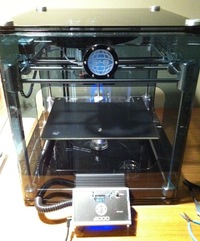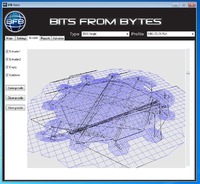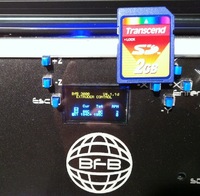 We’re continuing to evaluate the BFB 3000 3D printer, this time we’re focusing on the software experience. Previously we’ve looked at the unboxing and setup as well as its operation.
We’re continuing to evaluate the BFB 3000 3D printer, this time we’re focusing on the software experience. Previously we’ve looked at the unboxing and setup as well as its operation. Why focus on the software? Isn’t this all about the printer itself? We believe the entire experience is important, from end to end. And that involves software, mostly, because you’re not actually doing very much once you’ve hit the “print” button. Your experience with any 3D printer largely revolves around the software.
What should the software do? Assuming you’ve already got your paws on a delightful STL file to print, the software should do these things for you:
- Permit sizing of your model and positioning on the build platform
- Allow changes to the printer settings for different types of material or features
- Convert your model into slices and then into printer movement instructions (usually referred to as GCODE)
- Enable confirmation that the conversion was successful by visually depicting the printer instructions
- Transfer the printer instructions to the printer and control the printer
- Provide feedback on print operations
That’s not too much to ask, is it? But does your BFB AXON experience include all this stuff?
 The software associated with the BFB 3000 is AXON. AXON is basically a user interface layer built on top of the popular open source Skeinforge utility. Skeinforge is the software commonly used by low-end 3D printers to slice models and produce GCODE. Therefore, AXON is certainly capable of converting STL to GCODE, and even allows tweaking of the incredibly numerous Skeinforge settings.
The software associated with the BFB 3000 is AXON. AXON is basically a user interface layer built on top of the popular open source Skeinforge utility. Skeinforge is the software commonly used by low-end 3D printers to slice models and produce GCODE. Therefore, AXON is certainly capable of converting STL to GCODE, and even allows tweaking of the incredibly numerous Skeinforge settings. AXON comes with a set of default printing “profiles”. These are pre-tested Skeinforge configurations that correspond to different types of printing. For example, you might have one for ABS plastic using 0.5mm layer height, or another for PLA using 0.25mm layer height with 15% fill ratio, etc. We found the default profiles to work very well. We feared long sessions tweaking Skeinforge parameters to gradually “dial in” to the right combination for our BFB 3000. However, since the 3000 is factory assembled, there is great hardware consistency between individual 3000’s – thus a standard set of profiles actually works reliably.
One major problem we immediately encountered with the software was that AXON is Windows only. For our testing we ran AXON in Windows 7 running in VirtualBox under OS/X. Not exactly the optimum setup, but a situation where BFB 3000 owners might find themselves. The good news: it works just fine.
We found AXON’s scaling function to work pretty well, but the positioning functions were challenging. For these purposes and inspecting GCODE we simply used other tools outside of AXON (usually Pleasant 3D) that are easier to use.
Of the list of functions above, one that is simply not done by AXON is delivering the printer instructions and controlling the printer. Instead of attaching the software to the printer, you must download the GCODE to an SD card (provided). The SD card must be physically inserted into the 3000.
 At the BFB 3000 control panel you can browse the files on the SD card (although this can be tricky as only the first eight characters of the filename are shown – and the display itself is actually smaller than the SD card!) A file is selected and then the printer executes the instructions and faithfully produces your model. While the SD card process works, it does introduce extra steps (literally) for you to do.
At the BFB 3000 control panel you can browse the files on the SD card (although this can be tricky as only the first eight characters of the filename are shown – and the display itself is actually smaller than the SD card!) A file is selected and then the printer executes the instructions and faithfully produces your model. While the SD card process works, it does introduce extra steps (literally) for you to do. The BFB 3000 we’re testing includes two print heads – ideal for printing support material or a second color. However, there’s a software limitation. As far as we can tell, the second head can only be used for support material. Color changes are not really possible, although the presence of two heads and spools means it’s easy to physically swap filament between heads.
And what of the available third head? At this time it seems AXON doesn’t really support it. We had fantasies of using Red, Green and Blue filaments and being able to print color objects. However, the software and file formats are many, many miles away from such capabilities.
3D printing always takes longer than one suspects, and the BFB is no different. We’ve found printing takes much longer on the 3000 for several reasons:
- The extruder speed is relatively slow compared to some other printers: 16mm/sec
- The relatively high resolution means more layers and movements are typically required
- The large build envelope means you’re often printing pretty big things
Certainly AXON includes “high speed” print options at lower resolution, but usually you want high resolution – and that means lengthy prints. We’re now quite familiar with the notion of two to four hour prints. The longest print we’ve attempted was seven hours, and the BFB 3000 successfully completed the print (Thingiverse’s One Small Step) without any trouble at all.
 These long prints mean you’re much more conscious of the remaining print time. So how does the BFB 3000’s software provide this feedback? Not very well, we think. When your model is sliced it shows an estimated print duration in an AXON report. And that’s it. The printer itself has no ongoing display of progress, other than the current layer height in 1mm characters. We’d like to see an estimated time remaining feature.
These long prints mean you’re much more conscious of the remaining print time. So how does the BFB 3000’s software provide this feedback? Not very well, we think. When your model is sliced it shows an estimated print duration in an AXON report. And that’s it. The printer itself has no ongoing display of progress, other than the current layer height in 1mm characters. We’d like to see an estimated time remaining feature. Bottom line: The software experience on the BFB 3000 is awkward, but it does work. We don’t really like the long chain of different software tools and platforms required to get a model to the printer, as this is a barrier for less technical users. The BFB 3000’s hardware is wonderful, but the software could use some improvements.
Final update: We’ve obtained some intelligence that BFB has been working on an imminent major update to AXON: AXON 2! We understand this new version will significantly improve the user experience. More on that when we can get our hands on it.

